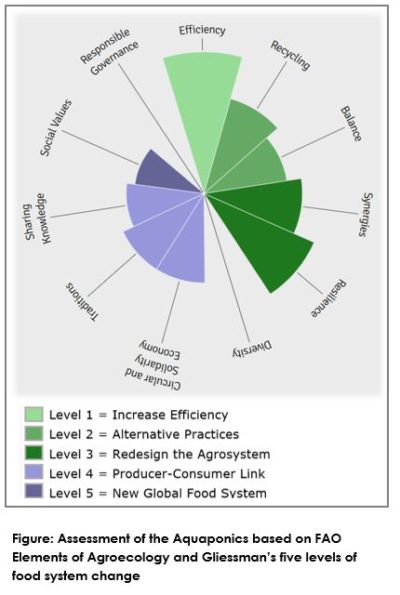Category:
![]()
Implementing Organisation:
FAO (Food and Agriculture Organisation of the UN)
Period:
2010 – now
In a nutshell

Aquaponics is the combination of soilless vegetable growing (hydroponics) and fish farming (aquaculture) within a closed recirculating system that uses nutrient-rich wastewater from the fish tanks as an organic fertilizer for plant production. This removes both the need for chemical fertilizers as well the disposal of fish wastewater.
FAO’s aquaponics pilot in the Gaza Strip comprised two phases – testing the approach in 2012 and then, in 2013 installing aquaponic systems for food insecure, poor and predominantly female-headed households.
Context
Food production in the Gaza Strip is constrained by an arid environment and limited access to steady sources of water. This threatens the food security and nutrition of local communities, which is further undermined by a wider context of protracted crisis and continued restricted access to critical livelihood resources for fishing and farming.
Objective
Installing aquaponic systems for increased food security of poor and predominantly female-headed households.
Key Interventions
Farm level:
- Installation of Aquaponics using the symbiosis of fish and plant production.
- Introduce an aquaponic system, using simple and locally available materials including plastic containers, gravel, pumps and plumbing
Regional/national Level:
- Identified locations and communities that would benefit most from aquaponic systems based on needs assessment
- Provide education and training programmes to develop farmers’ technical capacity
- Introduce and support aquaponics to households and establish demonstration units
Lessons Learned/challenges
A factor to success is to establish aquaponics where there is consistent electricity and access to plant seeds and fish.
The project was initially successful, enabling the participants to grow food. Women particularly benefited as the method enabled them to work within their homes. However, the pilot intervention were designed to assist the most vulnerable urban families with minimal farming experience first. After the initial provision of inputs however, many of the participating households lacked the resources to continue purchasing inputs, as well as the farming knowledge and experience to ensure satisfactory performance of the system.
Overall, the experience in the Gaza Strip highlights the potential of the system as an agroecological approach for special conditions and proofs its technical feasibility. However, one lesson learnt is also that the social conditions and some champion actors are key. It is important to include families who have the means and farming expertise to ensure profitability and sustainability of the aquaponics within the local context and then share their expertise.
Relevant Links & references
- FAO: “Urban agriculture in the Gaza Strip through vertical gardens and aquaponics”
- FAO: “Implementing aquaponics in the Gaza Strip”
- FAO: “Small-scale aquaponic food production”
